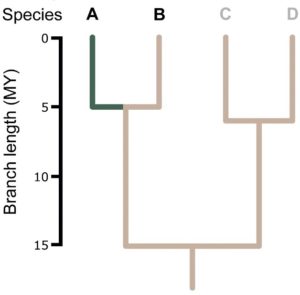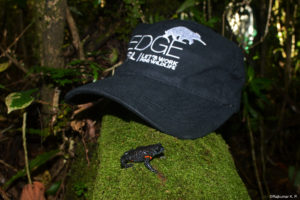Theodosius Dobzhansky – “Nothing in biology makes sense except in the light of evolution.”
The ‘Tree of Life’ is a metaphor used to describe the shared and unique evolutionary history of all life on earth, where the branches represent evolutionary time. Longer branches depict longer periods of time, and therefore more opportunities for the evolution of novel traits and features. Thus, the lengths of branches provide a proxy for measuring this variety, which forms the basis for a metric known as Phylogenetic Diversity (PD). For example, 84 mammals have become extinct since 1500 (IUCN, 2020), which has resulted in a loss of 250 million years of PD, which is 0.7% of the Tree of Life. This increases to 4.5 billion years (11.9%) if all 1244 threatened mammals were lost. More distinctive species with longer branches on the Tree have greater potential for loss of PD, so not all extinctions are equal.
The longer the branches of the phylogenetic tree, the more time there has been for the evolution of unique traits to occur.
But it’s not all bad news!
We can most greatly minimise the loss in PD by ensuring the survival of the most Evolutionarily Distinct and Globally Endangered (EDGE) species. Recent research* indicates that, even with the same number of extinctions, we could conserve 110% more mammalian diversity if we conserve these ‘high EDGE’ species relative to randomly selected threatened mammals. Since 1993, around 26 million years of mammal PD across 13 species, and 120 million years of bird PD across 26 species, has been saved by conservation action. These concepts form the basis of EDGE’s approach to bringing the most evolutionarily distinct and threatened species back from the brink of extinction.
By clarifying the phylogenetic relationships among species, we can provide historical context to how their unique adaptations evolved from a common ancestor and thus estimate how much evolutionary novelty each species represents. This is crucial for deciding where to prioritise the allocation of limited resources in conservation efforts and designing effective solutions to the issues facing our planet. For example, insight into the past evolutionary responses of different species to climate change, habitat loss, invasive species and other anthropogenic activities can help us to predict the adaptability of these species to future changes. Determining the mechanism and rate of current changes improves mitigation strategies and supports decisions to enforce the policies needed to protect rare and endangered species.
Protecting biodiversity also conserves productivity and the provision of the benefits of nature to humans. Recent work shows that maximising the amount of evolutionary history saved improves human wellbeing by capturing more benefits, like material resources, food, fuel and medicine. By building a more comprehensive understanding of how biodiversity benefits people, and implementing an evolution-based approach to conservation, we can prevent the loss of unidentified benefits via extinctions and enable more effective use of nature’s resources.
We asked some of our EDGE Fellows why they think evolutionary history is important in conservation, and here is what they had to say:
Rajkumar – Galaxy frog – c.2019-2021
– “I think that studying evolution will be very crucial to understand the species better and it would help for future conservation action plans. As galaxy frogs are only found in only four subpopulations in southern India, I would like to know more about their past.”
The Galaxy frog (Melanobatrachus indicus), found in the Western Ghats of India, is being studied by EDGE Fellow, Rajkumar.
Ayushi – Cantor’s giant softshell turtle – c.2019-2021
– “I think it’s easier for conservationists to make decisions to what to save and what not to save – it’s important because you can’t save everything at this point. So, I think it’s crucial to understand the evolutionary history of the animals or the plants that we are planning to conserve before starting conservation projects and know what impact it will have on the planet.”
Luan – Botsford’s leaf-litter frog – c.2018-2020
– “When we check data on the collection in the museum about a species, we only know very simple information which sometimes makes us misunderstand species. When you study evolutionary history and [the] combination of many methods like genetic data and ecology, we will know more about them. It supports you to have better conservation management.”
Marina – four EDGE frogs – c.2020-2022
– “Anthropogenic activities and climate change affect the fitness of species so to be sure that we are protecting the whole population of frogs, because we are not able to protect all the species, it is important to understand how species evolve with time [and] how species adapt their life to these kind of changes in the environment. It is also really important for policies and decisions.”
* This research is presented in preprint form and currently under peer review for publication

